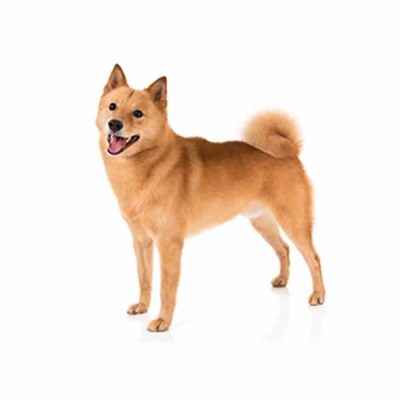Finnish Spitz
Group 4: Hound
Height: Ideal
Male: 47 cm
Female: 42 cm
Energy Level: Moderate to high
Original Function: Hunting
Lifespan: 10 – 12 yrs
Recommended for: Active people & families.
Note: Not many in Australia

Group 4: Hound
Height: Ideal
Male: 47 cm
Female: 42 cm
Energy Level: Moderate to high
Original Function: Hunting
Lifespan: 10 – 12 yrs
Recommended for: Active people & families.
Note: Not many in Australia

This breed is originally from Finland, where their name is Suomenpystykorva. Suomen is means Finnish from Finland and Pystykorva describes a prick-eared dog. Two breeders Hugo Roos and Hugo Sandberg strengthened the genetic pool of these dogs in Suomi. This prevented cross-breeding of the Finnish Spitz with other Spitz breeds.
They used these dogs for hunting birds and squirrels, which was essential food for their masters. They are an independent dog so firm training is needed but not harsh discipline. They will reach their mental mature age at about 4 years old. The Finnish Spitz is self contained. He is alert on his environment and will not bark unless something is wrong or unexpected and of course when he sees a bird. They make good home companions, watchdogs and are child-friendly.
Appearance: Medium sized, deep chested body. Eyes dark, lips & nose black. Pointed & erect ears. Tail bushy & curls over onto the back.
Temperament: Lively, vigorous, brave and determined. Possibly a little reserved towards strangers but never vicious.
Characteristics: their acute senses are utilised to find and alert the huntsman to the presence of his prey (generally birds, ducks).
Colour: The hair on the back is red or golden brown, preferably bright. A lighter shade inside the ears, on cheeks, throat, chest, belly, inside the legs, back of the thighs and on the tail. A white stripe on the chest and small white markings on the feet are permitted.
Coat: Rather long on the body, semi-erect or erect, stiffer on the neck and back. On the head and legs, except at the back of the hindquarters, short and close-lying. The stiff hair on the shoulders, especially in males, is noticeably longer and coarser. On the back of the thighs (trousers) and on the tail, the hair is long and dense. The undercoat is short, soft, dense and light in colour.
Grooming: A self-cleaning coat but a regular brush over and a comb through is still necessary. Needs to be brushed daily when moulting to free the undercoat (usually for a few weeks twice a year).
Exercise: Generally an adult will take as much exercise as you care to give it, but will be quite content and remain fit with a minimum of a 30 – 60 minute walk and a well fenced garden to run in.
Health: